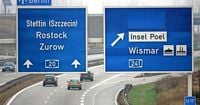As traffic congestion continues to plague various regions in Germany, local authorities and navigation services are stepping up efforts to provide real-time updates to drivers. On May 6, 2025, multiple traffic monitoring services reported significant slowdowns on key routes across several cities including Celle, Göttingen, Wismar, and Remscheid.
In Celle, the CZ-Staumelder highlighted areas where traffic is notably slower than usual, particularly on the Bundesstraße 3 (B3) towards Hannover and Soltau, Bundesstraße 214 (B214) towards Braunschweig and Schwarmstedt, and Bundesstraße 191 (B191) towards Uelzen. Additionally, the Wilhelm-Heinichen-Ring in Celle is currently experiencing delays due to ongoing construction work. These updates are sourced from TomTom, which utilizes GPS data from millions of devices, ensuring accuracy with updates every five minutes.
Meanwhile, Göttingen has also reported its share of traffic issues. The Tageblatt-Staumelder provided insights into the current traffic conditions, particularly on the A7 and A38 highways, as well as on several Bundesstraßen including B3, B241, B247, B248, and B446. The local authorities in the districts of Göttingen and Northeim have announced speed checks for the week, adding another layer of caution for drivers navigating these busy routes.
In Wismar and the surrounding areas, the OZ-Staumelder reported similar challenges. Key routes affected include the A14 and A20 highways, along with several Bundesstraßen such as B105, B106, B192, and B208. Notably, the Wismar-Mitte junction has become an accident hotspot, prompting concerns despite a speed limit of 60 km/h. The data for these reports also comes from TomTom, highlighting the widespread reliance on this navigation service for real-time traffic updates.
Remscheid is not exempt from traffic woes either. The RGA-Staumelder indicated significant congestion on the A1 and A46 motorways, which are among the most congested routes in North Rhine-Westphalia (NRW). The A1 alone recorded nearly 6,500 hours of traffic jams between Cologne and Dortmund in 2023, while the A46 is recognized as the sixth most congested route in the region. Local roads such as B229, B237, and B51/B51n are also experiencing delays, further complicating travel for residents and commuters alike.
To ensure accuracy, all traffic data reported by these services is derived from a combination of automatic data from around 80 million mobile devices, several million government road sensors, and manually maintained information. This comprehensive approach allows for timely updates, which are crucial for drivers looking to avoid delays.
As construction projects and accident hotspots continue to emerge, authorities urge drivers to remain vigilant and considerate of other road users. The importance of adhering to speed limits and being aware of changing traffic conditions cannot be overstated, especially in high-traffic areas.
In summary, the traffic conditions across these regions serve as a reminder of the ongoing challenges faced by drivers in Germany. With the assistance of navigation services like TomTom, authorities are working diligently to provide accurate and timely information to help ease the burden of congestion. As the situation evolves, drivers are encouraged to stay informed and adjust their routes accordingly to minimize delays.





